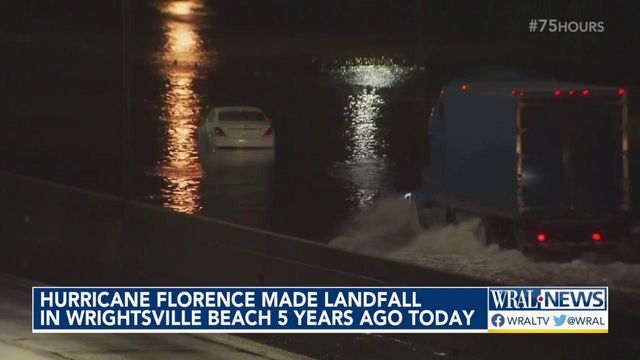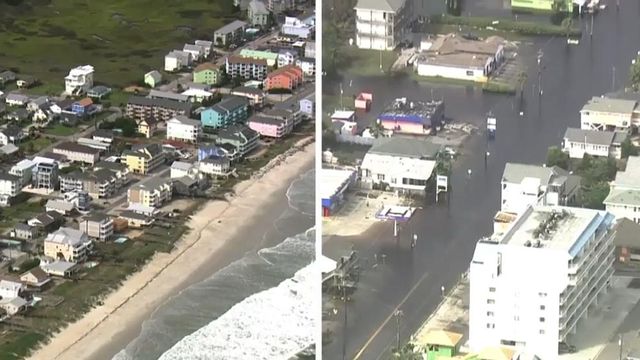Hurricane Florence made landfall in NC five years ago
Thursday marked five years since Hurricane Florence made landfall at Wrightsville Beach as a Category 1 hurricane.
Florence brought a state record 8.27-foot storm surge.
While Florence was at Category 4 strength (130-156 mph) on Sept. 10, 2018, it was an upper end Category 1 hurricane days later when it made landfall in North Carolina. Florence made landfall at 7:15 a.m. ET Friday, Sept. 14, 2018, according to the National Hurricane Center (NHC).
Over the next three days, it produced up to 30 inches of rainfall over eastern North Carolina. Interstates 95 and 40 were both closed due to flooding, and 42 people died across the state. It included a mother and her 8-year-old son who died after a tree fell on their house in Wilmington.
Nationwide, Florence resulted in 52 deaths.
The flooding cut off entire communities in eastern North Carolina.
After landfall, Florence made a slight jog to the west-southwest while maintaining a slow forward speed. The track allowed the center of the cyclone to remain close to the warm waters of the Gulf Stream just offshore, and the storm gradually weakened during this period.
Florence became a tropical storm on Sept. 15, 2018, when it was located over eastern South Carolina just north of Myrtle Beach. The tropical storm turned westward and moved slowly across central and northern South Carolina, weakening to a tropical depression by Sept. 16, 2018, about 35 miles south of Florence, South Carolina.
On Sept. 17, 2018, the depression went northward around the western periphery of a narrow high-pressure system centered just east of the Outer Banks. It passed over western North Carolina, eastern Tennessee, and western Virginia, before reaching western West Virginia, where it became extratropical.
The low turned northeastward ahead of an approaching frontal system and steadily weakened within an environment of strong westerly vertical wind shear. The system eventually dissipated over Massachusetts shortly on Sept. 18.
Florence’s highest wind speed was about 184 mph on Sept. 10, 2018, before it made landfall, according to the NHC.
The NHC’s report states Florence’s highest land-based sustained wind was a 10-minute average of about 82 mph at about 10 p.m. Friday, Sept. 14, 2018, at Cape Lookout.
WRAL News crews remember Hurricane Florence
WRAL News chief photographer Ed Wilson explained how he set up his videography equipment working with WRAL reporter Amanda Lamb.
“When the storm comes in, we’re going to put all our equipment inside the truck and shoot our talent outside of it,” Wilson said.
WRAL photographer Lauren DesArmo shared her experiences covering Florence.
“I’ve never seen anything like it,” DesArmo said. “It looked like a straight river, cars just flying into this floodwater and getting stalled out.”
Lamb recalled seeing pieces of sheet metal flying through the air when Florence made landfall.
“I can’t be out there right now,” Lamb said.
As Florence raged, first responders rescued people who were trapped.
The road to recovery took a long time.
Lamb recalled how gas lines were four hours long.
“I’m talking 30-40 cars down the road,” Lamb said.
"75 Hours" WRAL documentary details devastation Hurricane Florence left behind
How does a local television newsroom hope to cover what will be a relentless hurricane with historic flooding?
The documentary "75 Hours" tells the story behind the story of the people on the front lines of Hurricane Florence.
Aftermath: North Carolina hurricane victims still feel left behind years later
In the past decade, North Carolina residents have been hit with devastating hurricanes, and some are still dealing with the aftermath. Hurricane Matthew made landfall in 2016 and Hurricane Florence in 2018. The hurricanes caused catastrophic flooding and damage across the state.
The WRAL Documentary team investigated what happened to hurricane victims in the documentary "Aftermath: North Carolina Hurricane Victims Left Behind."











